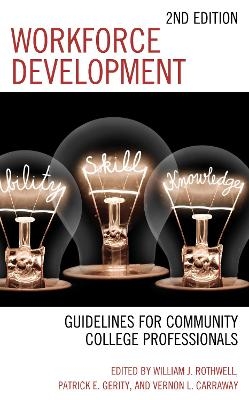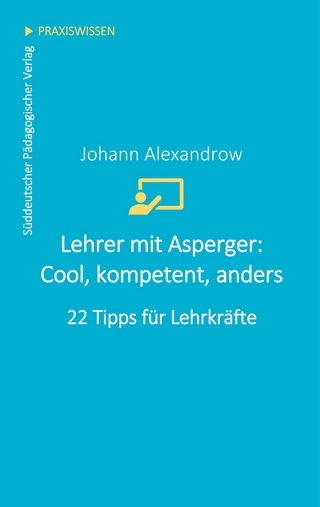
Workforce Development
Rowman & Littlefield (Verlag)
978-1-4758-4934-9 (ISBN)
Many people who work in Workforce Development in Community Colleges have not had the benefit of courses or a degree program in Workforce Development. For that reason, when they join a community college, they often need a primer on the purpose, goals and nature of workforce development. This book is intended for that purpose. It can help newly-hired community college staff members, administrators, and even board of trustees members on the important workforce development mission of a community college.
William J. Rothwell is a professor of workforce education and development on the University Park campus of The Pennsylvania State University. He is also president of Rothwell & Associates, Inc., a private consulting company. Patrick E. Gerity is a retired vice president of community college Continuing Education, Workforce and Economic Development. Patrick has spent the last 35 years working with community colleges in Workforce and Economic Development. Vernon L. Carraway is a Student Transition Course Designer on the University Park campus of The Pennsylvania State University. His blended learning and online courses equip the learner with numerous abilities, talents and competencies that are participant-centered, team-focused and experiential. Dr. Carraway’s courses are targeted in scope and application and focuses on our new leaders.
Table of Contents
Preface
Acknowledgements
Introduction
Part I. External Issues Affecting Community College Workforce Development
Chapter 1. Labor Market Information for Data-Driven Decision Making at Community Colleges by Alex Cooley
Defining Labor Market Information
Using Labor Market Information
Labor Market Information (LMI) and Community Colleges
Labor Market Information (LMI) at Northern Virginia Community College
NOVA LMI: Data for Good. Data for Business. Data for Learning
Conclusion
Chapter 2. Strategic Partnerships: Maximizing the Benefits of Partnerships
by Alicia R. Hooks
Competencies
Data
Organizational Placement
Conclusion
Chapter 3. Relationships Matter: Building Community Partnerships for Workforce Development by Robin Cole Jr.
Rules of Engagement
The Big Fish Mentality
Adjunct Faculty: Forgotten Faces within the Community
Do You Really Have a Partnership?
Toolbox to Build Partnership
Conclusion
Chapter 4. Building an Agile Community College: Strategic Transformation and Embedding Innovation as a Competency
by Sue Ellspermann
General Readiness Factors
Case Study
Developing a Creative, Innovative Culture
Simplexity
Honestly Assess Where You Are
Craft Mission, Vision, Core Value and Goals
“Wet Cement”
Affirmation and Roll Out
The First Year
Annual Strategic Plan Refresh
Celebrating Early Wins
When Is It Time for a New Plan?
Conclusion
References
Chapter 5. Rising with the Machines: Embracing Opportunity – and Living Your Values – in an Age of Transformation
by Lee D. Lambert
Lessons Worth Learning: A Checklist
Retooling Your Workforce for the Future
Policy vs. Culture and the Power of Empowerment
Conclusion
Part II. Internal Issues Affecting Community College Workforce Development
Chapter 6. Making a Case for Workforce Development
by Ty A. Stone
Understanding the Environment
Documenting the Process
Data Matters
Ensuring Buy-In
Conclusion
Chapter 7. Understanding Equity and Its Importance in Developing the Workforce of the Future by Angela Davis, Susan Paris, Jairo McMican
Diversity, Equity and Inclusion: What’s the Difference?
Tools for Understanding Equity
Conclusion
A Special Acknowledgement
References
Chapter 8. Technological Change: Human Adaptation Through Effective Learning
by Stephen R. Catt
Rapid Rate of Change in Technology and Its Effects on Learning
Addressing Strategic Workforce Challenges to Advanced Manufacturing
Futurists Predicted Rapid Technological Change
Specific Community College Challenges
Conclusion
Chapter 9. Embedded Industry Credentials: A Measure of Student Success
by Bryan Albrecht & Matt Janisin
Tactical Approach to Embedding Certifications
Case Study: National Coalition of Certification Centers (NC3)
Results
Conclusion
About Gateway Technical College
References
Chapter 10. Learning While Working
by Paul Schreffler
Tips for Building Work-Based Learning (WBL) Programs
Overview
What is Work-Based Learning?
Why Should We Consider WBL Strategies?
Common Benefits of Apprenticeship
How to Implement Work-Based Learning
Conclusion
Best Practices in Work-Based Learning: Build Relationships
References
Chapter 11. Finance and Budgeting for Workforce Professionals
by John Will
Step 1: Understand the Market
Step 2: Know the Financial Statements
Step 3: Understand the Budget Documents
Step 4: Monitor the Operation
Adopting a Continuous Improvement Mindset
Conclusion
Competencies
Part III. Special Issues Affecting Community College Workforce Development
Chapter 12. Factors Influencing the Retention and Persistence of African American and Latino
Male STEM Students in Community College
by Michael C. Wood
Factors of Influence
Educational Persistence
The Economics of Education: Financial Persistence
Human Capital Investment
Changing the Workforce Landscape
Program Modeling
Lessons Learned: Growth Initiatives
Conclusion
References
Chapter 13. Dealing with the Changing Face of Workforce Development
by Victor Rodgers
Partnerships
WorkKeys
STEP (Stand Up, Take Action, Expect Results, and Put in the Work)
Conclusion
Chapter 14. Conceptualizing Future Competencies Needed by Community College Workforce Development Practitioners
by William J. Rothwell, Patrick E. Gerity & Vernon L. Carraway
What Are Competencies?
How Are Competencies Traditionally Identified and Used?
Trends Shaping the Future
How Can the Future Competencies Needed by Workforce Development Practitioners Be Identified and Used?
Conclusion
References
Appendix I Rating Your Competence in Workforce Development
by William J. Rothwell, Patrick E. Gerity, Vernon L. Carraway
Appendix IISelected Resources for Community College Workforce Development Professionals
by William J. Rothwell, Patrick E. Gerity, Vernon L. Carraway
About the Editors
About the Contributors
| Erscheinungsdatum | 10.05.2021 |
|---|---|
| Verlagsort | Lanham, MD |
| Sprache | englisch |
| Maße | 155 x 223 mm |
| Gewicht | 299 g |
| Themenwelt | Sozialwissenschaften ► Pädagogik ► Bildungstheorie |
| Sozialwissenschaften ► Pädagogik ► Erwachsenenbildung | |
| ISBN-10 | 1-4758-4934-6 / 1475849346 |
| ISBN-13 | 978-1-4758-4934-9 / 9781475849349 |
| Zustand | Neuware |
| Haben Sie eine Frage zum Produkt? |
aus dem Bereich


